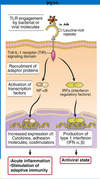Infection 2.1 Flashcards
(33 cards)
What are the 3 stages of innate immune system?
RECOGNITION of microbes and damaged cells ACTIVATION of mechanisms ELIMINATIOn of unwanted substances
What happens in the recognition stage?
uses pattern recognition receptors (PRR’s) to recognise PAMPs and responds rapidly to invading pathogens -activates other parts of the immune system and tissues throughout the body
What are PAMPs?
Pathogen associated molecular patterns molecular structures of microbial pathogen that required for survival
What two molecules does the innate immune system recognise?
PAMPs DAMPs by PRRs
What are DAMPs?
Damage associated molecular patterns result of cell damage by infections
What are the types of PRR’s?
1) Extracellularly
2) Intracellularly
3) Secreted used to tag; activate complement cascade
What are TLR’s?
Toll Like Receptors: expressed on plasma membrane and endosome membrane.
- activation of these receptors initiates a cascade of events that activates
- 3 main transcription factors:
1) NF-kB
2) AP-1
3) IRF’s
What is the NF-kB?
make pro-inflammatory cytokines eg TNFalpha that enhances immune response, induces apoptosis of infected cell Pro IL-B and Pro-Il18 Interleukin will enhance immune response through its chemotaxis effect and activation of lymphocytes
What is the AP-1?
adaptor protein which causes the differentiation, proliferation and apoptosis of cells
What are IRF’s?
interferon regulatory factors (IRF’s) that stimulate production of type I interferon (antiviral cytokines)
What are the transmembrane toll-like receptors?
identify bacterial structures or the outside of bacterial cells
Describe the signalling cascade?
Initial: 1) Loop structure; leucine-rich repeats , will identify a PAMP on a passing bacteria/microorganism and sets up a cascade of events
2) Toll-IL-1 receptor (TLR) signalling domain gets activated, either Initial effect: or Alternate reaction
- recruitment of associated adaptor proteins to that particular area; causes nF-kB to be activated; transcription factor
- increases activation of NF-kB
-causes activation of a number of genes: ie cytokines adhesion molecules costimulators
- Cytokines; attract neutrophils (recruitment), phagocytosis, signalling pattern, recruiting other immune cells+ acute inflammation
- increased vascularisation and stimulation of adaptive immune system:
- neutrophils recruit adaptive immune system to that site:
1) if friendly PAMP is detected, signalling cascade will not be activated
2)pathogen is detected, activation of:
-NFkB -increased cytokines
-acute inflammation+ secondary response

What is the alternate reaction?
- activation of IRF’s
- produces a type I interferon
- produces cellular changes that produce an anti-viral state
What are NOD-like receptors and how do they react with the inflammasome?
- highly conserved
- cytosolic receptors that sense DAMPs and PAMPs in the cytoplasm+ recognise cell walls in pathogens
- all NLR’s contain a NOD but different N-terminal domains (Nucleotide Oligomerisation Domain)
1) NOD1 2)NOD2 3)NLRP3
Difference between NOD1 and NOD2 AND NLRP3?
- NOD1 and NOD2 have caspase-related domains in their N terminal and bind to peptidoglycan which activated NFkB
- NLRP3 has a PYRIN N-terminal domain and recognises microbial products, substances that signal cell and damage/death (ATP, uric acid, potassium)
What happens when NLRP3 gets activated?
- NLRP3 oligomerises with an adaptor protein and an inactive form of caspase 1 to form an INFLAMMASOME
- once formed, the caspase 1 within the inflammasome becomes active and cleaves IL-1B into an active form of IL-1B, a mediator of inflammation that recruits leukocytes and induces fever
- (monomers in the inactive state; once activated, will bind with other adaptor proteins)
- cascade of events leads to NF-kB which transcribes genes for the cytokines
What is an inflammasom electron? Describe the mechanism of an inflammasome activation pathway
-a high molecular weight complex that activates inflammatory caspases and activates the cytokines of IL-1 family
Mechanism:
- a pathogenic bacteria gets sensed by NLRP-3 (sensor) NOD-like receptor, causes a chain of events
- recruitment of different proteins and creation of inflammasom eg initial caspase is also recruited
- inflammasom then releases active caspase-1 (cleaves and activates particular molecules)
- caspase-1 interacts with Pro-IL1B gene and CLEAVES it to active form of ILB1 ( active)
- secretion of IL1B causes acute inflammation
What is gout and how do like NOD-like receptors cause it and how does it create an inflammason? (NLR’s)
-swelling and painful joints
- uric acid crystals build up in joints; pain because of swollen+ inflamed joints
- NODlike receptors are responsible for gout attacks therefore they will identify uric acid crystals as a DAMP + activate their pathway through signalling cascade
- An inflammazom is created; which will cleave the proILIB to an active form , which will cause an inflammatory state ie recruitment of innate immune cells
- adaptive immune cells
- therefore increased permeability=====> swollen joints
What are other types of cellular receptors?
- CLR’s
- RLR’s
- CDS’s
- GPCR’s
What are CLR’s?
C-type lectin receptors -expressed on the plasma membrane of macrophages and dendritic cells detect fungal glycans and elicit inflammatory reactions to fungi
What are RLR’s?
RIG-like receptors, named after RIG-1;
- located in cytosol of most cell types and detect nucleic acids of viruses that replicate in cytoplasm of infected cells
- once activated, signal pathways lead to production of type 1 interferons
What are cytosolic DNA sensors?
CDC’s recognise viral DNA and induce type I interferon production
What are GPCR’s?
G protein Coupled receptors on neutrophils, macrophages, macrophages and other types of leukocytes recognise short bacterial specific peptides beginning with N-formylmethionine and stimulate chemotactic responses of the cells
What are the mechanisms of the innate immune response?
-Inflammation -Anti-viral defences



